Drive Away Hunger Golf Classic 2025
Join Community Table on August 25 at Fossil Trace Golf Club
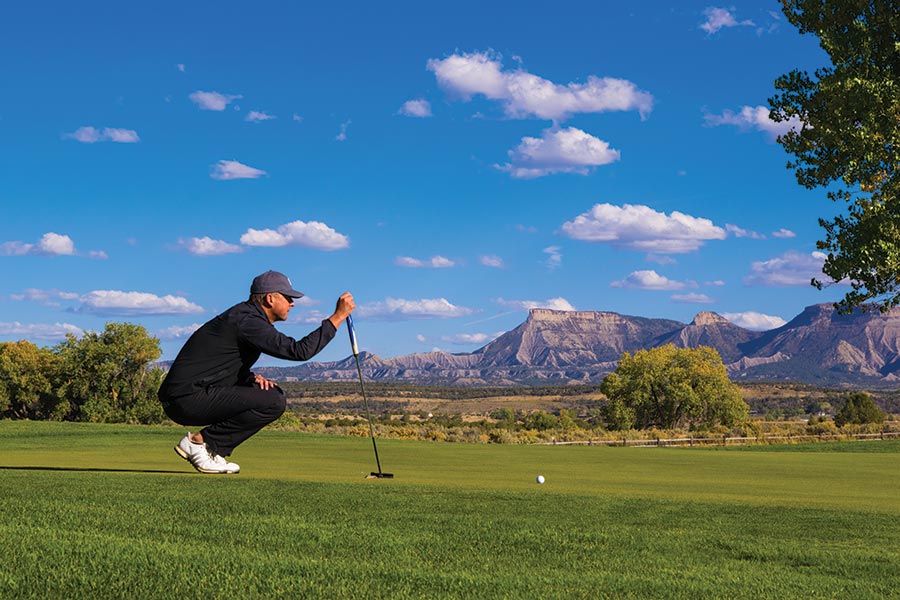
Apparently, some golfers in the Four Corners like to engage in a challenge peculiar to their region.
“It’s called the Four Corners Foursome,” Wayne, a member of my ad hoc group at Piñon Hills Golf Club in Farmington, New Mexico, informed me over a beer after our 18 holes. “You play nine holes in Arizona, Utah, Colorado and New Mexico in the same day.”
A Farmington native, Wayne knew I was on day three of a similar—albeit infinitely less manic—Four Corners rota, one that would also cover those four states, comprise five courses, last six days and consist of three times as many holes of golf.
This gauntlet of Wayne’s intrigued me. But having already played three memorable courses in Colorado, Utah and New Mexico—each separated from the other by an hour’s drive—I couldn’t imagine confining any of those experiences to just nine holes.
Ironically, I concluded, no day would last quite long enough to include Arizona as the fourth corner. That’s right: From the most famous quadripoint in the United States, the closest course in one of the most famous states for golf requires at least three hours behind the wheel.
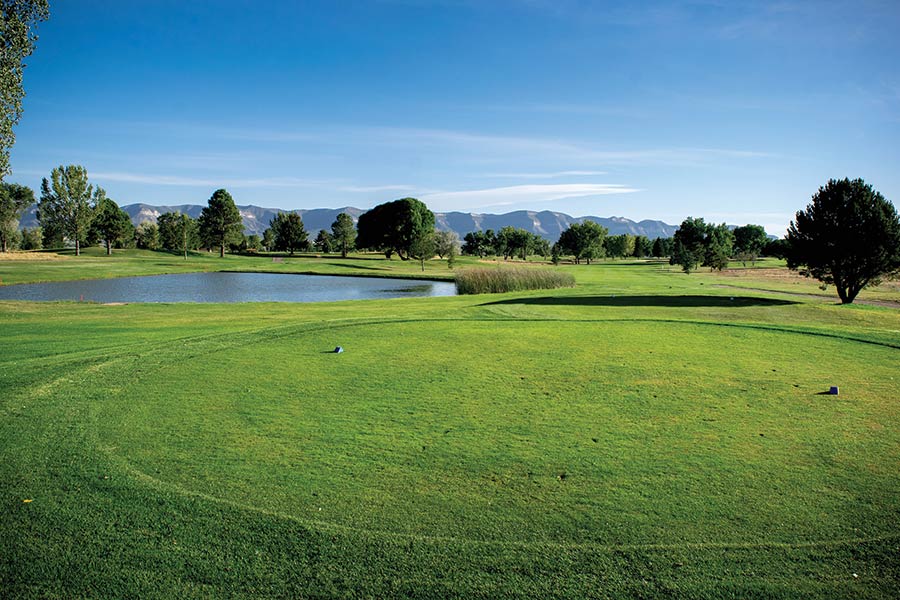
I figured if I’d wanted to spend a day chasing 72 holes in four different states, I could head to the East Coast, where entire states occupy less land than most Southwest counties. Besides, to appreciate golf in the land once inhabited by Ancestral Puebloans and their present-day descendants, you need to take your time and check out as much as you can—not rush through to check some box. Even six days can seem like a beautiful blur.
A glorious drive south through the lush San Juan National Forest—past Telluride, Mount Sneffels and Mount Wilson—drops you into Cortez. Located west of Mount Hesperus and the La Plata Range and north of the Ute Mountains, Cortez’s relatively flat topography suggests “high desert” more than “mountain foothills.” The Navajo made a seasonal camp here.
Believing the Aztecs had originally occupied the area, the city’s settlers in 1886 named it for the Spanish conquistador who in 1519 famously conquered Montezuma II’s Aztec empire. The vanquished emperor’s legacy survives on Cortez’s leafy Montezuma Avenue and in the name of the surrounding county. The enemies now find themselves united in the city’s Montezuma-Cortez School District.
Turns out those original dwellers weren’t Aztecs but forebears of the present-day Utes, Navajo and Hopi—whose federally protected settlements at Mesa Verde, Hovenweep and Canyon of the Ancients ring Cortez. These and other fascinating, bucket list-worthy ruins and cliff dwellings date back thousands of years and justifiably attract scholars and tourists by the thousands.
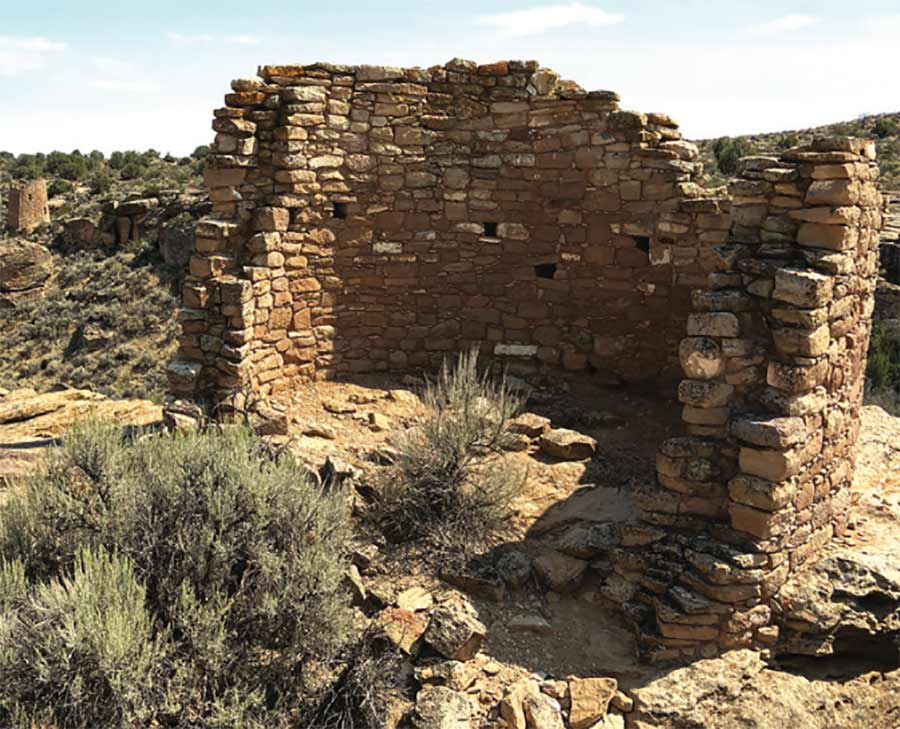
Another equally popular, but more modern, draw awaits atop a mesa just four miles east of Cortez. Phil’s World isn’t named for a certain lefthanded golfer, but for the late Phil Vigil, a local mountain biker who began carving out the renowned 26.8-mile (and growing) single-track and slickrock trail system in the late 1980s.
Conquistador Golf Course could be called Press’s World—not for the bets made during tournaments that bring in the high- rollers from Telluride and Durango, but for J. Press Maxwell, the Colorado Golf Hall of Fame architect whose nine-hole layout known as Cortez Golf Course opened in 1963.
As he’d done with his layouts at Hiwan, Rolling Hills, Pinehurst and others, Maxwell protected par with puny, fiddly, multitiered greens bordered by tiny fall-off greensites that place a premium on your short game. By 1979, the club’s professional, Bill Stroud, working from Maxwell’s plans, completed the construction of a second nine, and the city then renamed the 18-hole muni Conquistador.
Advancements in club and ball technology have forced Conquistador to stretch to 7,195 yards, and the cottonwoods, elms, pines and Navajo willows have matured into strategy-shaping giants. Water factors into eight holes, including the mirror- image par-5 first and 10th (where it lurks near the greens) and the 1-handicap par-5 fourth, a 568-yard hard-left dogleg with a stream bisecting the fairway and adding risk to cutting the corner.
Thanks to a dry summer, the course played hard and firm last August, with the trees and grabby rough making it imperative to keep your ball in the flattish fairways and on the right tier of the bentgrass greens.
The club’s PGA Professional Micah Rudosky says the course, which costs $41 to walk on weekends, looks and plays its best in May and June, “after the irrigation ditches flow, the spring winds die down and everything starts popping.”

Micah succeeded his father, Roland, as the club’s PGA Professional in 1997. Turning 50 last year, he earned a spot in this May’s Senior PGA Championship at Southern Hills Country Club in Oklahoma, which happens to have a Press Maxwell layout.
Off the course, a wide variety of restaurants line Main Street. Of the many Mexican joints, the fabulous La Casita de Cortez, carried the day. The Elk Shepherd’s Pie at the Loungin’ Lizard didn’t disappoint either, especially when washed down with a Monkey Wrench Pale Ale from Cortez’s Wild Edge Brewing.
Were I to make the trip again, I might add Durango. Hillcrest, a Frank Hummell layout, and the Ken Dye-designed Dalton Ranch both present challenges to match their fabulous views, and a stay at The Lodge at Tamarron gets you on the original Arthur Hills layout at Glacier Club, now known as the Valley Course.
A completely different—and dare I say, more prototypically “Colorado”—experience awaited 60 miles northwest of Conquistador in Monticello (pronounced “Monti-sello”). Apt- ly named, The Hideout Golf Club tucks into the verdant piedmont of the Abajo (aka Blue) Mountains, more than 7,000 feet above sea level, making it Utah’s highest golf course.
The clubhouse, which shares space with a community center, perches above a layout that spent almost 40 years as a nine-holer near a degraded uranium mill. Thanks to grant money from the U.S. Department of Energy, at the turn of the millennium the land underwent a massive overhaul by the original architect, Arthur Jack Snyder, and his partner, Forrest Richardson. The Phoenix- based architects moved 200,000 cubic yards of earth to construct an environmentally friendly layout with seesawing elevation changes that capitalized on the property’s natural glens, ridges, draws, creek beds and views of the magnificent Abajos.
At 6,654 yards from the tips, The Hideout doesn’t demand distance but strategy. More than once, a well-struck tee shot found the wrong side of the fairway, my approach blocked by trees or flirting with hazards. The short par 4s on holes 5, 12 and 15 define risk-reward, and by setting the green rather than the tee at the course’s highest point, the uphill par-4 16th providesa welcome break from the tee-high, green- low approach.
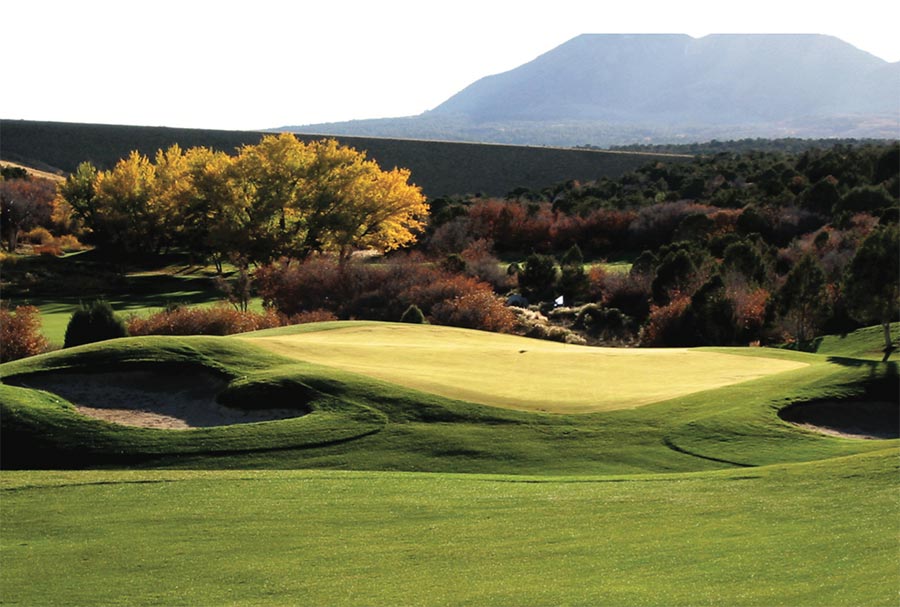
Each hole provides a delightfully hermetic experience, made more special by the abundance of fauna and the absence of any real estate. With few players and superb conditions, The Hideout remains a sequestered steal at $30, plus $16 for a highly recommended cart.
The lushness of The Hideout counter- pointed the baked landscape at Hovenweep National Monument, about 60 miles south- east on the way back to Cortez. Home to 10,000-year-old settlements straddling the Utah-Colorado border, Hovenweep criss-crosses mesa tops and canyon rims. A shuttered Visitor Center proved no deterrent to three hours of sundrenched appreciation of the brickwork and architectural ingenuity of the area’s early hunters and gatherers.
Whereas The Hideout is a “hidden gem,” for three decades, Piñon Hills Golf Course has enjoyed a national reputation as one of America’s best public golf courses. For less than $50 on weekends, the well-maintained, 7,198-yard Ken Dye-designed municipal lay- out provides a thrilling round—both visually and strategically—as it traverses striking rock formations in a hardscrabble landscape that’s as undulant as the tilde in piñon.
You’ll love the picturesque par-3 sixth, which requires you to carry a ravine and features nine tee locations, including a set suspended high above the others. The front nine climaxes with consecutive penal par 5s.
Piñon Hills’ back nine keeps a foot on the gas. Get too aggressive on either the short par-5 13th or short par-4 14th, and you’ll find yourself dropping a ball next to the water abutting the greens. Two brawny holes close the round—the heavily bunkered, uphill par-5 17th and the into-the-wind par-4 18th.
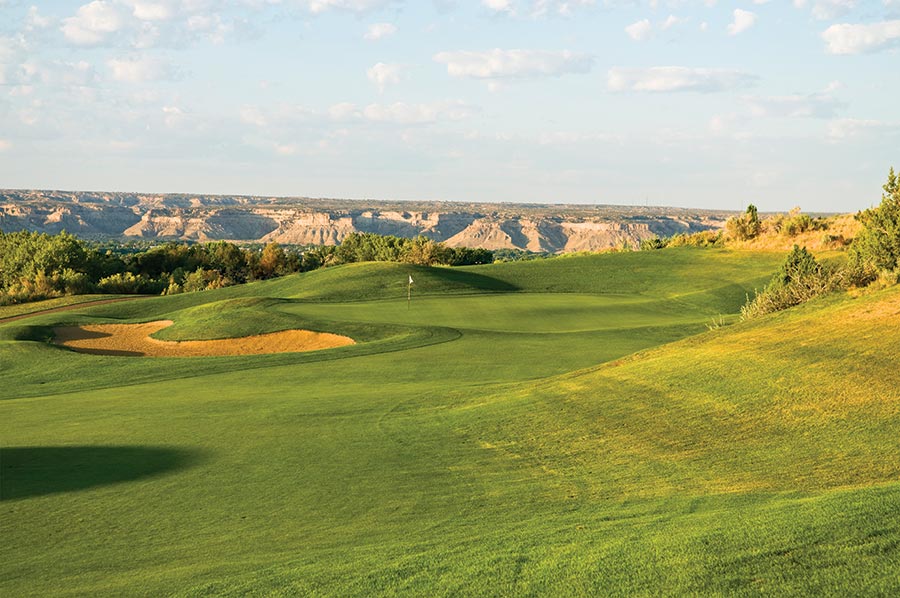
Piñon Hills was a treat, one made even more enjoyable by the locals who welcomed me to fill out their foursome rather than play through and linger over beers. They recommended visiting Farmington’s revitalized downtown—a hub of arts, shopping, restaurants and culture at the confluence of the San Juan, Animas River and La Plata rivers— but COVID restrictions and the prospect of an early-morning tee time at Riverview Golf Course in nearby Kirtland confined my options. I do, however, heartily recommend the cross-cultural pairing of Tonkotsu ramen and ’Merica Pale Ale at the Three Rivers Brewery Block.
At Riverview, situated 10 miles north- west of Farmington near the San Juan River, another unlikely pairing awaited: a flat, treelined parkland front nine dating to 1937 and a Piñon Hills-esque back nine designed by Baxter Spann 60 years later.
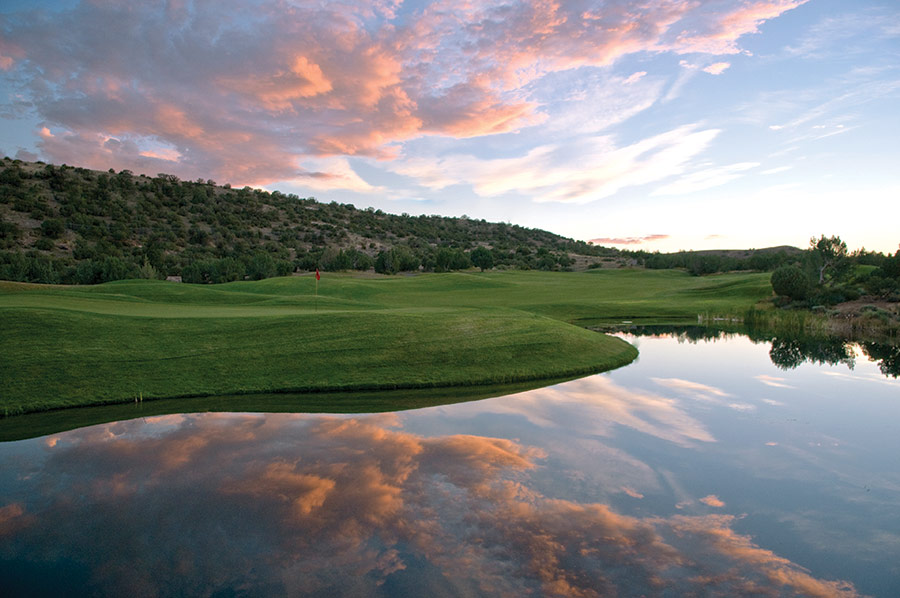
It’d be unfair to say the former merely serves as a warmup for the latter, as it doesn’t really prepare you for a second nine that winds and climbs and descends through high-desert terrain (and nothing would have prepared me for the huge pronghorn buck grazing on the 11th fairway, just 10 yards from my ball). The 15th, a 180-yard par 3 over scrub, features bunkers buttressed by railroad ties.
While unconventional, Riverview’s split personality makes it memorable. So do the views of the iconic Ship Rock monadnock from most holes, and you can’t beat the $28 price to walk it on weekends. A cart will run you $15.50.
The 217 miles between Riverview and Lake Powell National Golf Course cut through the 17.5-million-acre Navajo Nation, the largest land area in the United States retained by an indigenous tribe. The Nation got hit hard by COVID-19, leading to the temporary closure of the Four Corners Monument and countless disappointed tourists who’d come to be photographed on their hands and knees at the famous quadrangle.
The Navajo have thus far eschewed the casino-golf course parlay that other tribes have made, though a rough-hewn, grassless “Rez Golf” course across the sage and rabbitgrass outside the Arizona town of Steamboat has received some national media attention for its ingenuity.
Unfortunately, time didn’t allow for a three-hour detour to test my putting skills on “the browns.” The greens awaited at Lake Powell in Page.
And so did plenty of vacationers towing watercraft. Unlike any of the three previous destinations, Lake Powell and the Glen Canyon National Recreation Area thrive on tourism. In addition to electricity and irrigation, the dammed waters of the Colorado River bring boaters, jet-skiers and other aquatic enthusiasts to the reservoir defined by ruddy sandstone cliffs and canyons.
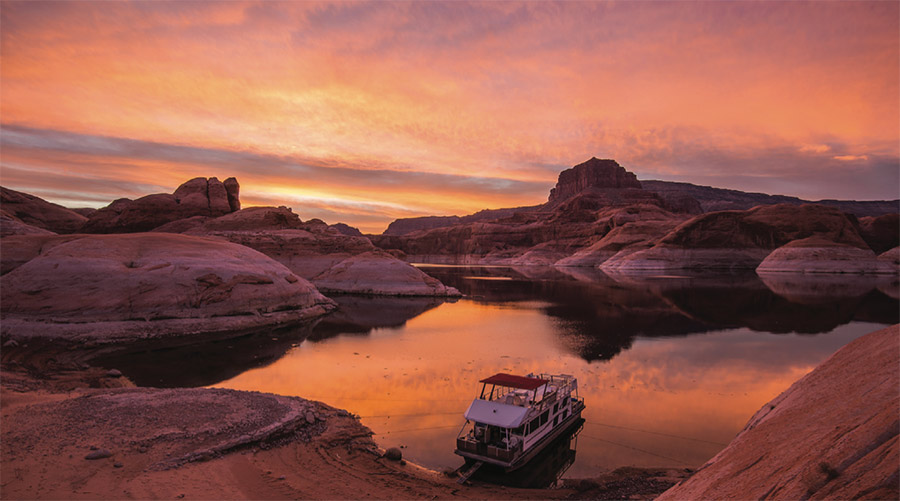
Lake Powell Resorts and Marinas provides a front-row seat to the activity. After a satisfying meal and sleep there, I headed to Lake Powell National. Designed by Bill Phillips, the course opened in 1995 in the sandstone mesas above its namesake reservoir. It features views of Lake Powell, the Glen Canyon Dam and Vermillion Cliffs—and no shortage of gorgeous golf holes.
After a straightforward opener, a lengthy ride to the second tee followed. I’d just recently covered a considerable amount of ground in my car, so this green-to-tee expanse seemed, well, par for the course.
Routing quirks aside, the course provided a stellar experience. Front-nine highlights include the blind, dogleg left third with a rock shelf guarding the green and two tantalizingly short par 4s on holes eight and nine.
The back nine ascends into the red rocks. The par-3 15th, which sits atop a precipice 120 feet above the shallow green, is pure eye candy. You’ll need to follow the long drive from the 16th green to the 17th tee with one off your clubface to reach the fairway on this 641-yard penultimate monster. A devilish three-tiered green makes the uphill par-4 18th a great bet-settler.
Lake Powell’s well-appointed clubhouse made for a relaxed place to reflect on the delightful and reasonable (a round here, with cart, tops out at $60) range of golf in the Four Corners. It also provided tasty nourishment for the return trip to the Corner I called home.
Minutes after setting out, however, I parked at the Horseshoe Bend Overlook, where a 10-minute hike rewards you with a clifftop view of the mighty Colorado making a 270-degree turn as it flows downstream towards the Grand Canyon, Nevada, California and on to Mexico and the Pacific. Somehow, watching this river navigate its eternal, inexorable and life- sustaining journey put a four-state golf trip into humbling perspective.
Jon Rizzi is the founding editor of Colorado AvidGolfer.
This article was also featured in the April Issue of Colorado AvidGolfer.
Colorado AvidGolfer is the state’s leading resource for golf and the lifestyle that surrounds it, publishing eight issues annually and proudly delivering daily content via coloradoavidgolfer.com.
Join Community Table on August 25 at Fossil Trace Golf Club
Steamboat Springs is like a secret only you and your friends know
Vail Valley is home to an endless array of summer outdoor pursuits